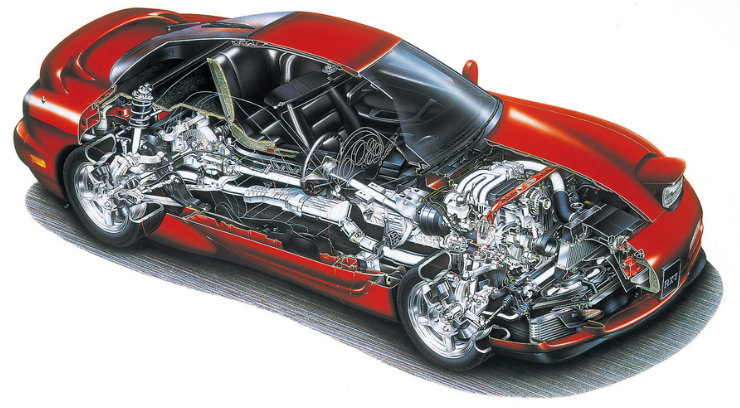The 1993 Mazda RX-7 was a beautifully flawed rotary missile
If you were a car enthusiast in the early 1990s, you probably had a poster of a 1993 Mazda RX-7 hanging somewhere in your room. It was elegant, aggressive and equipped with a rotary engine, making it one of the most distinctive sports cars of its time. The third generation RX-7 (FD3S) wasn't just another vanilla performance car. Even today, it remains very popular among gearheads who appreciate its lightweight design, near-perfect weight distribution, and high-revving turbocharged engine.
Despite the beauty and brilliance of the RX-7, it came with its fair share of quirks and mechanical problems. So, let's go over what made the 1993 Mazda RX7 an automotive icon, as well as some reasons why it might not be for everyone.
What made the 1993 Mazda RX-7 so special?
- Rotary engine magic "The RX-7's 1.3-liter twin-rotor 13B-REW engine was a work of engineering art. With twin sequential turbos, it produced 255 horsepower and 217 pound-feet of torque—impressive numbers for the early 1990s. The rotary's ability to rev effortlessly made for a thrilling driving experience."
- Featherweight structure Weighing only about 2,800 pounds, the RX-7 was one of the lightest sports cars in its class, and the lightweight body, coupled with a perfect 50/50 weight distribution, made it a dream to handle.
- Timeless design Even after 30 years, the RX7 FD's curvaceous body and pop-up headlights look stunning. The design wasn't just for show, it was carefully sculpted aerodynamically for beauty and performance.
- Impressive driving experience - The RX-7 was more than just straight-line speed, it featured a sophisticated double-wishbone suspension and provided its lucky drivers with a precise steering feel and connection to the road that few cars (at the time) could match.
- Tuned to perfection Mazda designed the RX-7's suspension, brakes and turbocharger to work in unison. This car rewarded skilled drivers (and punished negligent ones).
Where I fell short
- Rotary motor reliability issues -The 13B-REW was as tough as it was awesome. Rotary engines burn oil by design, which means regular maintenance is crucial. Neglecting it could lead to catastrophic engine failure. Not many RX7s have been able to survive past 100,000 miles without a complete engine rebuild.
- Turbocharger temperature problems - The twin turbines were a technological marvel of the time, but they also caused overheating and, over time, were prone to failure if not properly maintained.
- Fuel economy -Averaging about 16 mpg, the RX7 wasn't exactly frugal. For a lightweight sports car, it got excellent fuel mileage as a full-size SUV.
- Tight interior - The RX-7 was an unusually driver-focused car, but comfort took a backseat... literally. The cabin was comfortable, and the small rear seats were as useful as a third glove. Unless you're a young child or an amputee, you won't find any level of comfort there.
- Expensive to maintain - Although the car itself wasn't very expensive when new (starting at about $33,000 in 1993), keeping it running properly requires a steady flow of money and mechanical expertise.

1993 Rivals: RX-7 Rivals
The early 1990s were a golden age for Japanese performance cars. The RX-7 faced some stiff competition, both at home and abroad.
- 1993 Toyota Supra Turbo - Armed with the now legendary 2JZ-GTE engine, the MkIV Supra was a formidable force, with 320 horsepower and bulletproof reliability, it was heavier than the RX-7 but significantly more tunable.
- 1993 Nissan 300ZX Twin Turbo - Another twin-turbocharged Japanese monster, the 300ZX packs 300 horsepower from a VG30DETT V6. It was somewhat of a technological marvel but it weighed a lot more than the RX-7.
- 1993 Mitsubishi 3000 GT VR-4 - With all-wheel drive, twin turbos, and a 3.0-liter V6 producing 300 horsepower, the 3000GT was a straight-up beast, but its weight and complexity made it feel less nimble than the RX-7.
- 1993 Chevrolet Corvette C4 ZR-1 - American muscle met European refinement, as the ZR-1's LT5 V8 produced 405 horsepower, dwarfing the RX-7's output. However, the RX7's agility and light weight made it more fun on the twists and turns.
- 1993 Porsche 968 The RX7's European rival from Stuttgart had a 236-hp 3.0-liter inline-four, but it lacked the turbocharged power and exotic feel of the RX-7.
Why is the RX-7 still important?
Decades later, the 1993 Mazda RX-7 remains one of the most beloved sports cars in history. Its sturdy combination of lightweight construction, stunning design and engaging driving dynamics make it an enthusiast favorite. The aftermarket scene is booming for the RX-7, with countless modifications available to make it even more powerful. RX-7 modifications are so common that it's rare to see a completely original example from the factory anymore.
However, owning one today requires a certain level of commitment. These cars require careful maintenance, a constant supply of high-quality oil, and in many cases, a ready portfolio for the inevitable engine rebuild. If you're willing to put in the effort, few '90s cars offer as rewarding a driving experience as the RX7.
So, Japanese car fans, what are your thoughts on the 1993 Mazda RX-7? Dream car? Money pit? Maybe both? Have you owned one, or are you planning to? Drop a comment below!


